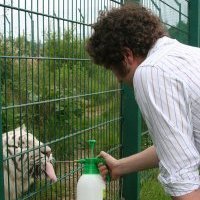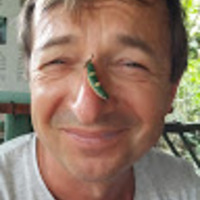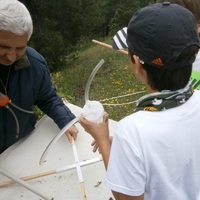Papers by Carlos Flechtmann

Cadernos De Agroecologia, Dec 29, 2013
Resumo: Condições climáticas, edáficas e florísticas podem influenciar na diversidade populaciona... more Resumo: Condições climáticas, edáficas e florísticas podem influenciar na diversidade populacional de insetos em matas nativas. O objetivo do estudo foi o de avaliar a variação temporal e o efeito borda no número de insetos em uma floresta ombrófila mista situada em área de preservação permanente. Foram instaladas armadilhas de impacto de vôo iscadas com etanol em transecto da borda ao centro do fragmento floresta. As coletas foram realizadas a cada 14 dias, de agosto de 2011 a julho de 2012. As ordens Diptera, Lepidoptera, Coleoptera e Hymenoptera foram as mais abundantemente coletadas. A maior abundância foi encontrada nos meses mais quentes, de fevereiro a abril. Representantes de Coleoptera e Hymenoptera foram os mais sensíveis ao efeito de borda, tendo sido capturados em maior quantidade no interior do fragmento, em comparação à borda. Palavras-chave: armadilha de impacto de vôo; etanol; variação sazonal.

Environmental Entomology, 1999
ABSTRACT Many species of bark and ambrosia beetles use host volatiles as cues for breeding site l... more ABSTRACT Many species of bark and ambrosia beetles use host volatiles as cues for breeding site location. In a study where the objectives were to identify the different volatiles released by Pinus taeda L. billets as they age, to determine the arrival sequence of scolytids (Coleoptera: Scolytidae), and to correlate volatile emission by the billets with beetle catches, 25 species of scolytids were trapped. Bark beetles were more attracted to the billets in the beginning of the period, whereas ambrosia beetles arrived later. Among the bark beetles, Dendroctonus terebrans (Olivier) was significantly more attracted during the 1st 3 wk after tree felling, Hylastes tenuis Eichhoff in the 1st 2 wk, Pityophthorus pulicarius (Zimmermann) in weeks 2 and 3, and Ips grandicollis (Eichhoff) was more attracted on weeks 3 and 4. Among the ambrosia beetles, Xyleborinus saxeseni (Ratzeburg) was more attracted to billets during weeks 4-6, whereas Xyleborus pubescens Zimmermann and Xyleborus californicus Wood were more attracted during week 6. The billets showed marked decline in attractiveness to all scolytids after 8 wk. Volatiles collected during the beetle trapping periods included 15 hydrocarbon monoterpenes, 18 oxygenated monoterpenes, 4-allylanisole, and ethanol. The hydrocarbon monoterpenes and 4-allylanisole decreased sharply over time, but oxygenated monoterpenes and ethanol increased up to weeks 4-6, after which they also decreased. Good correlations between certain billet volatiles and catches for some beetle species were obtained, but their biological significance could not be determined.

Scolytidae are among the most destructive conifer forest pests throughout the world. The phleopha... more Scolytidae are among the most destructive conifer forest pests throughout the world. The phleophagous species (bark beetles) are the predominant group in temperate regions, where they cause millions of dollars in losses in outbreak years. Xylomycetophagous ambrosia beetles predominate in the tropics, and they cause, when compared to bark beetles, less damage, and it is more difficult to quantify. In Brazil, ca. 35% of the reforested area is occupied by tropical and subtropical Pinus species, all of which exotic. Scolytid beetles are growing in abundance and diversity in these forests, but to date no attacks on live trees were registered. While the host selection mechanism for some bark beetles, including primary and secondary attraction, has been studied intensively, host-selection behavior for the ambrosia beetles has generally received little attention. Several ambrosia beetles are known to respond to the kairomone ethanol (primary attraction), but recent experiments showed that s...
Revista do Instituto Adolfo Lutz
A weekly survey of Bostrichidae was carried out with ethanol-baited flight traps model ESALQ-84, ... more A weekly survey of Bostrichidae was carried out with ethanol-baited flight traps model ESALQ-84, at four heights (40, 60, 80 and 100 cm), between September 1984 and March 1987, in Agudos, São Paulo State, Brazil. Only 4 species, Micrapate brasiliensis, Dolichobostrychus gracilis, Xyloperthella picea and Bostrychopsis uncinata were trapped. M. brasiliensis was the most trapped, frequent, constant and abundant species. Higher positioned traps caught significantly more insects. Peak of flight occurred at the beginning of the rainy season.
Nine flight heights of ethanol baited flight traps model ESALQ-84 were tested, between November 1... more Nine flight heights of ethanol baited flight traps model ESALQ-84 were tested, between November 1987 and October 1998, in a Pinus caribaea v. hondurensis stand. Six species were trapped, where Bostrychopsis uncinata was the most frequent, abundant and captured one. Bostrichidae (coleoptera) flight height preference in general was for 2.0 m but only for B. uncinata there was a statistically significant difference, with this species being more captured at 2.0 m traps too. Heavy flights occurred in months of October/November, coincident with an increase of rainfall after a dry season.
A weekly survey of Bostrichidae was conducted with ethanol-baited flight intercept traps model ES... more A weekly survey of Bostrichidae was conducted with ethanol-baited flight intercept traps model ESALQ-84, from September 1984 auntil March 1987, in five tropical pine and in one native "cerrado" stands, at four trap heights. Twelve Bostrichidae species were trapped, where Micrapate brasiliensis, Bostrychopsis uncinata, Xyloperthella picea and Dolichobostrychus gracilis were the most captured ones. Bostrichid species showed preference for stands, and capture of bostrichids was significantly higher in Pinus oocarpa stand. Flight peaks were not affected by stand characteristics, and varied from species to species.
Revista do Instituto Adolfo Lutz
A weekly survey of Bostrichidae was carried out with ethanol-baited flight traps model ESALQ-84, ... more A weekly survey of Bostrichidae was carried out with ethanol-baited flight traps model ESALQ-84, at four heights (40, 60, 80 and 100 cm), between September 1984 and March 1987 in 5 tropical pine species stands in Agudos, São Paulo State, Brazil. Twelve species were collected, being Micrapate brasiliensis, Bostrychopsis uncinata, Xyloperthella picea and Dolichobostrychus gracilis the most abundant. Flight height preference and population peaks for each species and stand were determined. The lowest positioned traps caught significantly less specimens than other ones. Capture peak occurred once a year for B. uncinata and X. picea and twice for M. brasiliensis.

Southern Brazil, mainly the northwestern region of the state São Paulo, has the largest plantatio... more Southern Brazil, mainly the northwestern region of the state São Paulo, has the largest plantations of rubber trees, Hevea brasiliensis. This tree is considered to oppose a formidable resistance to boring beetles, due to its characteristic latex exudation when their vessels are cut. Surprisingly though, in the last five years the number of reports of trees killed by ambrosia beetles (Scolytinae and Platypodinae) increased dramatically. Beetles show the ability of killing from young to mature trees, associated or not with phytopathogenic fungi, such as Ceratocystis, Fusarium, Colletotrichum and Lasodiplodia. In October 2012 we visited a plantation where large number of trees were being killed by an association of fungi and beetles (F&B) in Sud Mennucci (São Paulo). One stand had 2,054 clones PB235 and GT1 trees, 16-yr old and homogeneous in crown formation; of those, 180 trees (9%) were killed by F&B. The other and nearby stand had 9,439 clones RRIM600 and PB235 trees, 21-yr old, and...
Three new species of Sampsonius EGGERS, 1935 (Coleoptera: Curculionidae: Scolytinae) are describe... more Three new species of Sampsonius EGGERS, 1935 (Coleoptera: Curculionidae: Scolytinae) are described from Brazil, Ecuador, and Peru: S. lepusculus, S. lapidosus and S. militaris. Sampsonius ensifer WOOD, 2007 is synonymized with S. giganteus SCHÖNHERR, 1994. The male of S. dampfi SCHEDL, 1940 is described for the first time. New records and a key to the world species of Sampsonius is given.

Para rubber, Hevea brasiliensis Müll. Arg. is native to the Amazon basin, but the largest Brazili... more Para rubber, Hevea brasiliensis Müll. Arg. is native to the Amazon basin, but the largest Brazilian plantations are found in southern Brazil. São Paulo state concentrates the largest plantations, mainly in the northwest. Most of the few pests reported to Para rubber are found in their leaves, while trunk and branches are rather rarely attacked. Recently, we recorded several Scolytinae and Platypodinae attacks on rubber trees, usually associated with trunk diseases. The objective of this experiment is to evaluate Curculionidae populations in rubber plantations of different ages, and located in Santana da Ponte Pensa, northwest São Paulo, Brazil. Stand 1 (4 ha) was composed of 25-year old PB 235 trees in the productive phase (tapping started in 1997); site 2 (1 ha) is 4-year old, clone RRIM 600 trees in the immature phase; site 3 (0.5 ha) had also clone RRIM 600 8-year old trees, whose tapping started in less than one year. Site 2 was bordering a 6-ha riparian forest fragment, where t...
Several factors may contribute to stress a rubber tree, hence turning it more prone to attack by ... more Several factors may contribute to stress a rubber tree, hence turning it more prone to attack by beetle trunk borers, Scolytinae and Platypodinae (Curculionidae). One 'standard' stressing factor is man-induced, the tapping activity. We were interested in learning how the tapping activity influences the abundance of these beetles in a Hevea brasiliensis clone RRIM 600 plantation, by trapping them in pre-tapping and tapping periods. For the vast majority of the species, there were no statistically significant differences in abundance between periods. We believe this was due to the fact that perhaps considering this was still the first tapping year, stress was still mild on trees, not reaching a level where beetles would benefit from it and attack trees.
Nematropica
Protocylindrocorpus brasiliensis n. sp. (Diplogastroidea: Cylindrocorporidae) is described from r... more Protocylindrocorpus brasiliensis n. sp. (Diplogastroidea: Cylindrocorporidae) is described from reproductive stages removed from galleries of the ambrosia beetle, Euplatypus parallelus (F.) (Curculionidae: Platypodinae) in Para rubber trees (Hevea brasiliensis) in Brazil. This is the first record of the genus Protocylindrocorpus from the Neotropics. Males of P. brasiliensis are quite striking because their long spicules extend up to 72% of their total body length. The adults exhibit “conspecific agglutination” where they congregate in a slimy substance that serves to maintain them in a coherent group for mating. Some of the adults were infected by fungal and protozoan pathogens, implying that disease plays a role in regulating natural populations. The discovery of P. brasiliensis provides new information on nematode structure, behavior, and ecology.
This is the first report in the literature of several biological aspects of Euplatypus parallelus... more This is the first report in the literature of several biological aspects of Euplatypus parallelus (Curculionidae: Platypodinae), including the description of its gallery system, egg, larval, and pupal stages. There is a generation overlapping, and we investigated the number of young and adult stages inside a gallery. We provided data on the number of beetles than can colonize a tree, and the height on the trunk they can reach while attacking trees. For the first time in Brazil, we list potential natural enemies of E. parallelus.

Chayote is a climbing vine, native to Mexico and Guatemala. In Brazil, the state of São Paulo is ... more Chayote is a climbing vine, native to Mexico and Guatemala. In Brazil, the state of São Paulo is its largest producer. It is mainly cultivated in the hills of the Serra da Mantiqueira, and usually in small areas. In the last few years, growers were facing constant problems caused by beetle borers. The objective of this research was to determine the species associated with damage to chayote. We examined material from three properties (P). P1 was in Amparo (22°44'41.93"S 46°43'22.23"W), with a planted area of 1.25 ha, plants were 4-yr old, attacks started in the summer of 2012, and with losses topping 40% plants. P2 was in Monte Alegre do Sul (22°44'19.31"S 46°39'06.80"W), cropped area was 5.12 ha, plants were 6-yr old and attacks also started the summer of 2012. P3 was also in Amparo (22°43'55.69"S 46°44'17.34"W), area of 1.5 ha, 4-yr old plants, and that over the years experienced frequent and intense attacks. We collected attack...

Environmental Entomology, 1999
ABSTRACT Ambrosia beetles are the predominant Scolytidae in Brazil. Little is known about the att... more ABSTRACT Ambrosia beetles are the predominant Scolytidae in Brazil. Little is known about the attractiveness of exotic conifer tree volatiles to native scolytids. Objectives were to compare the attractiveness of logs with and without bark of Pinus oocarpa Schiede, P. caribaea variety bahamensis Barrett & Golfari, P. car. variety caribaea Barrett & Golfari and P. car. variety hondurensis Barrett & Golfari over time to native scolytids in different pine stands, to compare the relative attractiveness of logs relative to ethanol traps, to determine how long it takes for logs to become attractive to ambrosia beetles and when attraction peaks occur, and to determine if volatiles released by live standing trees would mask volatiles released by logs of the same species. In young stands, Hypothenemus was the predominant insect genus, whereas in older stands Xyleborus predominated. Debarked logs trapped more beetles than logs with bark. Pine log species attractiveness was not influenced by volatiles present in the stand. Beetles were divided into the following 3 groups, based on response to log volatiles and ethanol: (1) species attracted to ethanol and not responding to pine terpenes Ambrosiodmus hagedorni (Iglesia), A. retusus (Eichhoff), X. spinulosus Blandford, Corthylus schaufussi Schiede, Cryptocarenus heveae (Hagedorn), H. obscurus (F.), (2) species attracted to ethanol but responding to pine terpenes Xyleborinus gracilis (Eichhoff), X. affinis Eichhoff, H. eruditus Westwood, Premnobius cavipennis Eichhoff, and (3) species more attracted to pine terpenes and less responsive to ethanol, A. obliquus (Le Conte), X. ferrugineus F., X. catulus Blandford. Pinus car. variety bahamensis was the least attractive pine, P. oocarpa the most attractive. The attraction peak varied according to the season; logs were not attractive to beetles 10 wk after cutting.
Pesquisa Florestal Brasileira, 2011
Resumo-Este é o primeiro registro do ataque de besouros (Curculionidae, Scolitinae), no Brasil, c... more Resumo-Este é o primeiro registro do ataque de besouros (Curculionidae, Scolitinae), no Brasil, causando danos em plantios de nim, entre 7 e 10 anos, em Brejinho de Nazaré, Tocantins. Os insetos foram identificados como, Xylosandrus compactus (Eichhoff), Cryptocarenus diadematus Eggers, 1937 e Hypothenemus sp. Westwood, 1836. Os plantios atacados apresentavam crescimento abaixo do esperado para a região, baixa produção de sementes, desfolhamento acentuado e rebrota intensa nos ramos, seguida por morte de brotos jovens e/ou do ápice do ramo. A ação dos insetos provocou pontos de exsudação intensa de goma nos orifícios provocados. O fato tem similaridade com a síndrome denominada "declínio do nim", relatada na África.











Uploads
Papers by Carlos Flechtmann